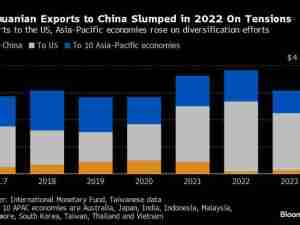Australia, one of the world’s largest wheat exporters, will produce another huge crop this season, which is set to boost agricultural export earnings by almost 50% from a decade ago.
Growers are on track to harvest 32.2 million tons of wheat in 2022-23, just shy of last year’s all-time high of 36.3 million tons, according to government forecaster Abares. That’s up 6.3% from its previous outlook as favorable weather conditions during winter buoyed yield potential across most crops.
The prospect of more supplies should offer some relief to a world facing an uncertain grain outlook as the war in Ukraine and extreme weather wreak havoc on harvests in parts of Europe, the US Farm Belt and China. Soaring crop prices have contributed to food inflation that’s been gripping the world.
Australia, meanwhile, is reaping the benefits of exceptional growing conditions and high global prices. Agricultural export earnings are forecast to climb to a record A$70.3 billion ($48 billion) for 2022-23 -- almost 50% more than what it was a decade ago after accounting for inflation, Abares said.
A bumper canola crop is also expected, with output seen at 6.6 million tons, the second-largest after last season’s record of 6.8 million tons. Still, the outlook from Abares isn’t quite as high as some other forecasts. IKON Commodities estimates wheat and canola at 35.8 million and 6.7 million tons respectively.
More details from Abares:
- Winter crop production is forecast to reach 55.5 million tons, the fourth-highest on record. Production is forecast to be well above 10-year averages in all states.
- Australia is expected to deliver 25.8 million tons of wheat to global markets in 2022-23, just below last season’s record of 26 million.
- A third straight La Nina is forecast for late 2022. While good for national production prospects, it could lead to significant localized impacts such as flooding, livestock losses, and quality downgrades for crops like those seen in 2021–22.
- Urea imports to Australia have not slowed despite prices being around 3 times higher than average. This indicates that fertilizer supplies will be sufficient over the 2022–23 season, although higher costs will erode farm margins.
- There’s been a dramatic shift in Australian cotton export destinations. Since unconfirmed reports in 2020 that Chinese importers were told to stop buying Australian fiber, Australian exports have become more diversified. In 2021–22, Vietnam and Indonesia have emerged as the largest export destinations.




